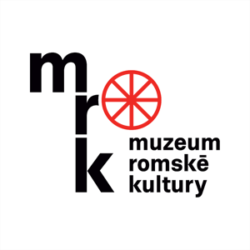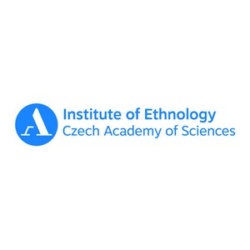Anastázie Bystřická
Anastázie Bystřická, née Adamová, born 1924, Opatovice, Přerov district
-
Testimony abstract
Anastázie Bystřická had two brothers who were twins, and three sisters. The eldest sister Božena lived with Alois Danihel; they were not married and had three children. Only her father František Adam went out to work; her mother Františka Adamová and the other women of the family were at home. They had two covered wagons near the village of Špičky, but they used them only for living.
Gendarmes from the gendarmerie station in the village of Černotín came for the family.[1] The gendarmes told them to pack, but to take only essentials, as they would return immediately. At the station in Černotín they were photographed and their personal details were recorded. From there they were taken to the prison in Hranice, where other Romani families had been taken, and then to Olomouc, where they stayed in a building that Bystřická likened to a courthouse with large rooms. She didn’t know exactly how long they were there; again, more Roma arrived from the surrounding area, and finally they were all transported by passenger train to the concentration camp in Hodonín.[2] Anastázie Bystřická said there were already Roma prisoners in the camp at that time, but not many of them.
After they had arrived in Hodonín, their hair was cut off, their body hair shaved, and they were given camp clothing.[3] All the prisoners in the camp, men, women and children, had to work; they built a road through the forest using pickaxes and loaded earth and mud into carts. Anastasia Bystřická rode in a cart and worked with her younger sister and an old man. One day the wood used to brake the cart broke; the old man couldn't hold the cart, he let go and it went out of control. No one was hurt, but the cart was derailed. Anastasia Bystřická took the blame and was brutally beaten: the gendarme who beat her with a stick counted two blows as one. For several days afterwards she could not walk, although she went to the roll call in the morning, but then she reported to the sick bay, where she spent three days.
After about a year they were taken in cars to the station, loaded onto a freight train, and, she said, travelled like cattle; they knew they were being taken to Auschwitz concentration camp. They were given a piece of bread and jam for the journey. When the train stopped, SS guards with rifles were waiting for them and they were herded on foot into the camp, where they were tattooed with numbers. The prisoners knew that in Auschwitz people were being sent to the gas chamber and that they would be given soap and a towel beforehand. When they too received them, all of them - the whole family – were terrified and in tears, but these really were showers; then they were given camp clothing and taken to the block.
The “block elders” were, in her opinion, even worse than the SS. She mentions a guard known as “Many”, who did not treat their family so badly, although he did others.[4] The second “block elder” [who is not named] is said to have behaved even worse. She stated that they got to know Many and his wife and that this was probably why he treated them better.
At the beginning of August, Anastasia Bystřicka was transported from Auschwitz to Ravensbrück[5] and from there to a small camp in the woods, the name of which she cannot remember, but where the prisoners were mainly Jewish women. By that time, Allied planes were flying overhead and the Germans demanded that the camp be kept dark and quiet. She no longer remembered how long she spent there.
From there, the women prisoners set out on a death march. They had nothing to eat, so they dug around in the earth or ate raw meat from horses that had been shot. They had no water, and were not allowed to drink. As soon as they made any move that might look like an escape attempt, the guards threatened to shoot them. By the time they arrived in a courtyard, even the guards were tired, so they decided to rest there. Four or five young women decided to escape, saying that they would rather be shot on the spot than have to go on. They hid, and when they came out in the morning, the prisoners and the guards were gone.
Together with the other women, Anastasia Bystřicka then walked past empty houses where people were fleeing from the approaching Red Army. They were mainly looking for food; then they would go into the forest and cook something to eat, but they immediately vomited everything they ate. In the morning they met a soldier walking towards them across the field. One of the women, Poldina, could speak German and Polish and was able to talk to him. He was Russian, and he told them that all around were forests and Germans in them who would shoot them. He then accompanied them from house to house and ordered the people who had returned in the meantime to cook for the women.
- [1] It is not stated when.
- [2] It is not stated when.
- [3] The prisoners of the Gypsy camp in Hodonín were dressed in discarded military uniforms. (ed.)
- [4] The nickname Many was given to Blažej Didy, a Czech Romani man who was a low-ranking prison functionary in the gypsy camp and for this activity was sentenced to life imprisonment by the special people's court in Brno on 29 April 1947. (ed.) His name is also spelled “Dydy”, and his nickname also appears in other sources as “Mannus” or “Man”. Schuster, Michal. Proces s Blažejem Dydym na základě materiálů Mimořádného lidového soudu v Brně roku 1947. In: Romano Džaniben 1/2013.
- [5] Transport of 2 August 1944 (ed.)
They all went home together, going from village to village, their lodging mostly arranged by the local mayor. People voluntarily gave them food once they began to describe their experiences. Eventually they reached Ostrava, where they split up. Anastázie Bystřická went to Hranice and found only her aunt, her mother's sister. Then her niece Adéla [Reiskupová] heard about her return, and came to get her and they remained together.
How to cite abstract
Abstract of testimony from: NEČAS, Ctibor, ed. Nemůžeme zapomenout = Našťi bisteras : nucená táborová koncentrace ve vyprávěních romských pamětníků. Olomouc: Univerzita Palackého, 1994, 85-88. Testimonies of the Roma and Sinti. Project of the Prague Forum for Romani Histories, https://www.romatestimonies.com/testimony/anastazie-bystricka (accessed 12/5/2025) -
Origin of Testimony
The tape recording and transcript of the narration of 3 September 1987 was made by Ctibor Nečas. Anastázia Bystřická's niece Adéla Reiskupová was present at the interview.
-
Where to find this testimony




